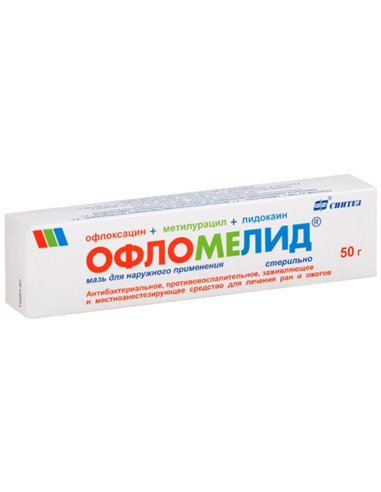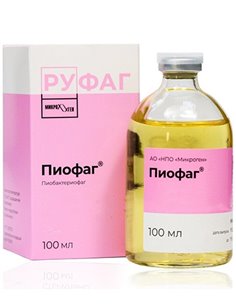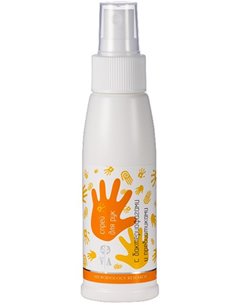Your cart
There are no more items in your cart
per 100 g: active substances: ofloxacin - 1 g, dioxomethyltetrahydropyrimidine (methyluracil) -4 g, lidocaine hydrochloride monohydrate (in terms of lidocaine hydrochloride) - 3 g; excipients: methyl parahydroxybenzoate (nipagin or methylparaben), propyl parahydroxybenzoate (nipazole or propyl paraben), propylene glycol, macrogol-1500 (low molecular weight polyethylene glycol-1500, polyethylene oxide-1500), macrogol-400 (low molecular weight polyethylene glycol-400, polyethylene oxide-400).
Oflomelid® is a combined drug that has an antimicrobial, anti-inflammatory, local anesthetic, regenerating effect. The active substances are ofloxacin, methyluracil and lidocaine.
Ofloxacin is a broad-spectrum antimicrobial agent from the group of fluoroquinolones. It has a bactericidal effect due to the blockade of DNA gyrase in bacterial cells. DNA gyrase is essential for replication, transcription, repair, and recombination of bacterial DNA. Its inhibition leads to the unwinding and destabilization of bacterial DNA and, consequently, to the death of the microbial cell.
Microorganisms highly sensitive to ofloxacin (MIC ≥ 0.5 mg/l):
gram-positive aerobes - Staphylococcus aureus methi-S (methicillin-sensitive strains), Staphylococcus coagulase negative (coagulase-negative staphylococci: Staphylococcus epidermidis, Staphylococcus saprophyticus, Staphylococcus haemolyticus, Staphylococcus hominis, etc.);
gram-negative aerobes - Aeromonas hydrophila, Bordetella spp., Brucella spp, Campylobacter jejuni, Citrobacter spp. (including Citrobacter freundii), Enterobacter spp. (including Enterobacter cloacae, Enterobacter aerogenes, Escherichia coli, Haemophilus ducreyi, Haemophilus influenzae, Haemophilus parainfluenzae, Klebsiella spp. (including Klebsiella pneumonia), Moraxella (Brahamella) catarrhalis, Morganella morganii, Neisseria gonorrhoeae, Neisseria meningitides, Plesiomonas spp, Proteus spp. (Proteus mirabilis, Proteus vulgaris (indole + and indole -)), Providencia spp., Salmonella spp., Serratia (including Serratia marcescens), Shigella spp. (including Shigella sonnei), Vibrio spp. (including Vibrio cholerae, Vibrio parahaemolyticus) , Yersinia spp. (including Yersinia enterocolitica);
anaerobes - Clostridium perfringens, Helicobacter pylori, Propionibacterium acnes;
others - Chlamydia trachomatis, Legionella spp., Mycoplasma spp. (including Mycoplasma hominis).
Microorganisms moderately sensitive to ofloxacin: Acinetobacter spp. (including Streptococcus pyogenes, Streptococcus pneumoniae, Streptococcus viridians) - only penicillin-sensitive strains, Ureaplasma urealyticum.
Microorganisms resistant to ofloxacin (MIC> 1 mg / l): Acinetobacter baumannii, most strains of Enterococcus spp., Listeria monocytogenes, Nocardia spp, (including Nocardia asteroids), methicillin-resistant strains of Staphylococcus aureus and Staphylococcus spp. (Staphylococci methi-R), Treponema pallidum.
Methyluracil is a tissue repair stimulator. It has anabolic activity. Accelerates the processes of cellular regeneration in wounds, accelerating the growth and granulation maturation of tissue and epithelialization.
Lidocaine has a local anesthetic effect due to the blockade of Na + channels, which prevents the generation of impulses in the endings of sensory neurons and the conduction of impulses along nerve fibers. When applied externally, it dilates blood vessels, does not have a local irritating effect.
The water-soluble (hydrophilic) and hypermolar base of the ointment is a mixture of polyethylene oxides (polyethylene glycols) with a molecular weight of 400 and 1500 (PEO-400 and PEO-1500 or PEG-400 and PEG-1500), which provides a dehydrating (moisture-absorbing) and osmotic effect on tissue, which is 20 times stronger than 10% sodium chloride solution and lasts up to 18-20 hours.
Indications
Infected wounds of various localization and etiology in the first (purulent-necrotic) phase of the wound process, incl. accompanied by a pronounced pain syndrome (infected burns II-IV stage, bedsores, trophic ulcers, postoperative and post-traumatic wounds and fistulas, wounds after opening abscesses, phlegmon, after surgical treatment of abscessed boils, carbuncles, hydradenitis, festering atheromas, lindens, etc. .).
Outwardly, 1 time per day for 1-2 weeks. After the standard treatment of wounds and burns, the ointment is applied directly to the wound surface with a thin layer (after which a sterile gauze bandage is applied) or on a gauze bandage, followed by application to the lesion. The cavities of purulent wounds are loosely filled with tampons soaked in ointment after their surgical treatment, and gauze turundas with ointment are introduced into the fistulous passages.
In the treatment of purulent wounds, the ointment is used once a day, in the treatment of burns - daily or 2-3 times a week, depending on the amount of purulent discharge. The maximum daily dose should not exceed 100 g. The duration of treatment depends on the dynamics of wound cleansing from purulent exudate and the timing of the relief of the inflammatory process.
Oflomelid® is a combined drug that has an antimicrobial, anti-inflammatory, local anesthetic, regenerating effect. The active substances are ofloxacin, methyluracil and lidocaine.
Ofloxacin is a broad-spectrum antimicrobial agent from the group of fluoroquinolones. It has a bactericidal effect due to the blockade of DNA gyrase in bacterial cells. DNA gyrase is essential for replication, transcription, repair, and recombination of bacterial DNA. Its inhibition leads to the unwinding and destabilization of bacterial DNA and, consequently, to the death of the microbial cell.
Microorganisms highly sensitive to ofloxacin (MIC ≥ 0.5 mg/l):
gram-positive aerobes - Staphylococcus aureus methi-S (methicillin-sensitive strains), Staphylococcus coagulase negative (coagulase-negative staphylococci: Staphylococcus epidermidis, Staphylococcus saprophyticus, Staphylococcus haemolyticus, Staphylococcus hominis, etc.);
gram-negative aerobes - Aeromonas hydrophila, Bordetella spp., Brucella spp, Campylobacter jejuni, Citrobacter spp. (including Citrobacter freundii), Enterobacter spp. (including Enterobacter cloacae, Enterobacter aerogenes, Escherichia coli, Haemophilus ducreyi, Haemophilus influenzae, Haemophilus parainfluenzae, Klebsiella spp. (including Klebsiella pneumonia), Moraxella (Brahamella) catarrhalis, Morganella morganii, Neisseria gonorrhoeae, Neisseria meningitides, Plesiomonas spp, Proteus spp. (Proteus mirabilis, Proteus vulgaris (indole + and indole -)), Providencia spp., Salmonella spp., Serratia (including Serratia marcescens), Shigella spp. (including Shigella sonnei), Vibrio spp. (including Vibrio cholerae, Vibrio parahaemolyticus) , Yersinia spp. (including Yersinia enterocolitica);
anaerobes - Clostridium perfringens, Helicobacter pylori, Propionibacterium acnes;
others - Chlamydia trachomatis, Legionella spp., Mycoplasma spp. (including Mycoplasma hominis).
Microorganisms moderately sensitive to ofloxacin: Acinetobacter spp. (including Streptococcus pyogenes, Streptococcus pneumoniae, Streptococcus viridians) - only penicillin-sensitive strains, Ureaplasma urealyticum.
Microorganisms resistant to ofloxacin (MIC> 1 mg / l): Acinetobacter baumannii, most strains of Enterococcus spp., Listeria monocytogenes, Nocardia spp, (including Nocardia asteroids), methicillin-resistant strains of Staphylococcus aureus and Staphylococcus spp. (Staphylococci methi-R), Treponema pallidum.
Methyluracil is a tissue repair stimulator. It has anabolic activity. Accelerates the processes of cellular regeneration in wounds, accelerating the growth and granulation maturation of tissue and epithelialization.
Lidocaine has a local anesthetic effect due to the blockade of Na + channels, which prevents the generation of impulses in the endings of sensory neurons and the conduction of impulses along nerve fibers. When applied externally, it dilates blood vessels, does not have a local irritating effect.
The water-soluble (hydrophilic) and hypermolar base of the ointment is a mixture of polyethylene oxides (polyethylene glycols) with a molecular weight of 400 and 1500 (PEO-400 and PEO-1500 or PEG-400 and PEG-1500), which provides a dehydrating (moisture-absorbing) and osmotic effect on tissue, which is 20 times stronger than 10% sodium chloride solution and lasts up to 18-20 hours.
Indications
Infected wounds of various localization and etiology in the first (purulent-necrotic) phase of the wound process, incl. accompanied by a pronounced pain syndrome (infected burns II-IV stage, bedsores, trophic ulcers, postoperative and post-traumatic wounds and fistulas, wounds after opening abscesses, phlegmon, after surgical treatment of abscessed boils, carbuncles, hydradenitis, festering atheromas, lindens, etc. .).
Outwardly, 1 time per day for 1-2 weeks. After the standard treatment of wounds and burns, the ointment is applied directly to the wound surface with a thin layer (after which a sterile gauze bandage is applied) or on a gauze bandage, followed by application to the lesion. The cavities of purulent wounds are loosely filled with tampons soaked in ointment after their surgical treatment, and gauze turundas with ointment are introduced into the fistulous passages.
In the treatment of purulent wounds, the ointment is used once a day, in the treatment of burns - daily or 2-3 times a week, depending on the amount of purulent discharge. The maximum daily dose should not exceed 100 g. The duration of treatment depends on the dynamics of wound cleansing from purulent exudate and the timing of the relief of the inflammatory process.
4602565022891




